
Sexual Health for Young Men
If you have more than one partner, have recently changed partners or have just started a new relationship – a sexual health check is a really great idea.
If you have never have had a sexual health check and don’t know what to expect- we can promise you seeing a doctor or nurse to have a test for sexually transmissible infections (STIs) is much less scary than you might think.
What is an STI?
STI stands for sexually transmissible infection. These infections, such as chlamydia, can be passed from person to person by:
- having unprotected sex (vaginal, anal or oral)
- genital to genital contact.
- Chlamydia is the most common STI in New Zealand. It is most commonly diagnosed in males aged 20-24 and females aged 15 to 19
When to get tested for an STI?
It is a really good idea to get tested for an STI:
- if you have had unprotected sex (vaginal, anal or oral)
- before you begin a new relationship
- if a condom broke – get tested (a few weeks later) and get some tips to make sure condoms are much less likely to break next time
- as part of a general health check up
- if you have symptoms or just feel something isn’t quite right
What symptoms might I have?
Many STIs have no symptoms which makes it hard for you to know if you have an STI. This is why it is important to have regular tests.
In about a quarter of chlamydia cases, and sometimes with other STIs, men will have no symptoms so won’t know that they have an STI.
If you do have symptoms of an STI, these could include:
- pain when you pee
- pain when you have sex
- an unusual discharge or smell
- lumps, bumps or sores
- sore testicles.
What happens at an STI test?
An STI test is not so scary. The nurse or doctor will ask a few basic questions about your sexual history such as:
- How long since your last STI check, if you’ve ever had one?
- Do you have any symptoms?
- Have you had a recent change of partner?
- What types of sex have you had (because some sexual activity is more high risk than others)?
They’re not being nosey or judging you – they are just trying to get information so they know what tests you need.
These tests may include:
- A urine test – that’s where you pee in a pot
- In most cases only a pee test is needed. Occasionally a urethra, throat or anal swab may be needed (depending on the STI being tested for and your sexual activities).
- A physical check – the nurse or doctor will look at your penis, testicles and scrotum for any sign of infection
- A blood test – if the nurse or doctor is checking for HIV/Hepatitis/Syphilis
For most men with no symptoms, to have an STI test they’re simply going to have to pee in a pot.
Tips for testing
Try not to pee for at least one hour before your appointment so the urine test will work better.
If you have symptoms, get tested ASAP.
Myths busted
We all hear all sorts of stories and myths about STIs – here are a few myths busted:
- There are no little umbrellas or big needles in uncomfortable places. Our staff come armed with nothing scarier than a small cotton swab
- You don’t need to be sleeping around to get an STI. Having unprotected sex just once with someone who has an STI can be all it takes to get infected
- Some people say condoms don’t work. They do! It is far safer to use a condom than not to. They offer great protection against most STIs and unplanned pregnancy
What if I don’t get tested?
In men, untreated chlamydia can lead to further problems such as:
- urethritis (inflammation of the tube from the bladder)
- epididymo-orchitis (inflammation of the testicles)
- reactive arthritis (joint pains)
- infertility
Best to be proactive and get regular STI tests or, better still, use condoms every time!

